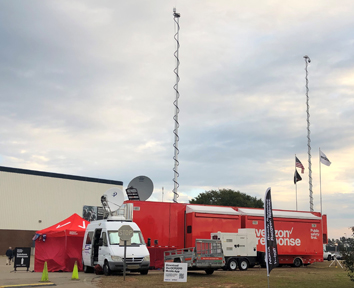Case Study: Verizon’s Operation Convergent Response
Communications in the aftermath of a disaster are a critical enabler for relief agencies to coordinate response efforts and to get help to those that need it. Yet connectivity is often difficult to establish, especially when terrestrial infrastructure is overloaded or has been destroyed, or simply unavailable.
The Challenge
When time is of the essence, the first responder and Non-Government Organization (NGO) communities require robust, easy-to-deploy communications that will enable them to help lift the fog of confusion after or even during a serious or catastrophic event. The current global pandemic provides us with a first-hand example of a global crisis where teams must be quickly mobilized across the globe to enable emergency treatment, testing and assessment. It is therefore essential that these teams have access to connectivity wherever it is required - at field hospitals, at drive-thru testing centers in parking lots, for connectivity on-the-move onboard ambulances and other medical vehicles and even onboard medical ships moored to help patients. Connectivity assists inter-agency coordination and communication, telemedicine, expert assessment, transfer of patient files and information sharing at a time where this can mean the difference between life and death.
Internet connectivity is essential to collect, send and receive data from collaborative cloud platforms that are often specially developed for use by disaster workers. It is also used to communicate with headquarters and with the team in the field, via voice, email and instant messaging.
The Solution
 |
| The Verizon Operation Convergent Response (OCR) truck at OCR 2019 where attendees had the opportunity to observe six different scenarios to demonstrate first responder solutions and innovations. (image courtesy of ST Engineering iDirect) |
Recognizing the value of technology innovation and preparedness, Verizon and Nokia host an annual public safety technology expo and live demonstration event, Operation Convergent Response (OCR), at the Guardian Centers in Perry, GA that brings together the world’s most innovative companies to showcase and test their technologies with first response teams during live emergency response operations. OCR attendees have the opportunity to observe different disaster scenarios, all driven by real-life global events that put technology and teams to the test so when events do happen, agencies on the front line are ready, able to respond, can help recover, and ultimately rebuild.
An integral part of the emergency connectivity portfolio leveraged at OCR are satellite communications (satcom) technologies. Requiring no prior infrastructure in order to operate, satcom-enabled mobile command centers and comms-on-the-move vehicles help empower first responders to share information about hard-hit areas, to coordinate essential services, to enable residents to check in with loved ones and to eventually restore communities.
“Verizon brings an overlay by providing traditional voice and data communications over satellite, as well as delivering LTE in the impacted area while using satellite as the backhaul transport to the global network,” said Stuart Burson, Associate Director, Satellite Solutions Group, Verizon Response Team. “Satellite is critical for first responders to perform their jobs and to enable victims to contact their loved ones and apply for emergency aid.”
At OCR2019, attendees had the opportunity to observe six different scenarios to demonstrate first responder solutions and innovations.
ST Engineering iDirect demonstrated its satcom solutions during the Cyberattack on Critical Infrastructure scenario. With satellite-enabled mobile command vehicles, emergency response teams can send data — from video to voice — en route to and at the frontlines of a disaster site. These mobile command vehicles can also help residents connect with loved ones, coordinate essential services and restore communities.
During the scenario, ST Engineering iDirect’s satcom solutions powered a Kymeta u7 terminal mounted on a Can-Am vehicle so first responders could establish a common operating picture and help build situational awareness directly from the scene. The u7 terminal’s flat panel antenna, paired with an iDirect Very Small Aperture Terminal (VSAT) modem, is small enough to fit on a variety of emergency vehicles, from patrol cars to SWAT.
“Toggling between cellular and satellite is a critical feature we’ve been using for years in our networks, and the iQ LTE router will make our design much more efficient,” said Jeff Schweitzer, Asymmetric Solutions Architect at Verizon. “While the macro network is offline, the iQ LTE remote would operate on satellite networks (satellite backhaul, etc.) as needed, when the LTE network returns, they could use the LTE network as a primary means of communication.”
 |
|
To read or download a pdf of the full report on Satellite Cellular Backahul sponsored by ST Engineering iDirect click here. |
Powered by Dialog®, Verizon’s cells-on-wheels (COWs) and Cells-on-Light-Trucks (COLTs) were equipped with iDirect’s satellite routers to provide backhaul speeds up to 100+ Mbps. In disaster response scenarios, COWs and COLTs are used to re-establish critical voice and data connectivity in times when traditional wireless connectivity is not available. The COWs and COLTs can be driven to the area where connectivity is required and can be instantly deployed, creating a network where one didn’t exist previously or was destroyed.
Today, satellite is also empowering new technologies, such as drones and the Internet of Things (IoT) sensors, to further help first responders on the ground when cellular and fiber networks are down. Satellite can also be used to aggregate the information collected (images, GPS coordinates, video clips) to send back to HQ or to quickly analyze and form actionable intelligence.
The Result
Satellite technology facilitates critical on-the-move and on-the-pause communications and continuity of operations regardless of what terrestrial infrastructure is available. As Stuart Burson explains, satellite has become an integral part of Verizon’s emergency connectivity mix and is set to play a bigger role as the company continues to add satellite capabilities to their wireless response fleet to enable them to respond more rapidly. “We are using more high-throughput satellite product offerings, like those from ST Engineering iDirect, to augment the bandwidth required for LTE communications. Bandwidth needs are always growing and satcom will be critical.”
The Verizon team is constantly looking to the future to expand its communications portfolio and become even more effective in the field and expects 5G and other emerging technologies to play an important part in the future of relief communications.
To view more information on ST Engineering iDirect's satellite cellular backhaul solutions go to: info.idirect.com





